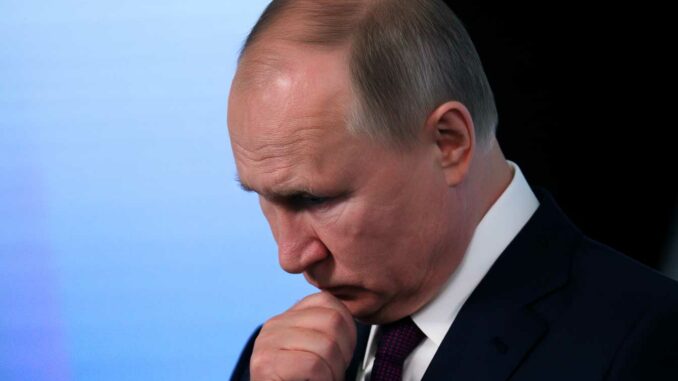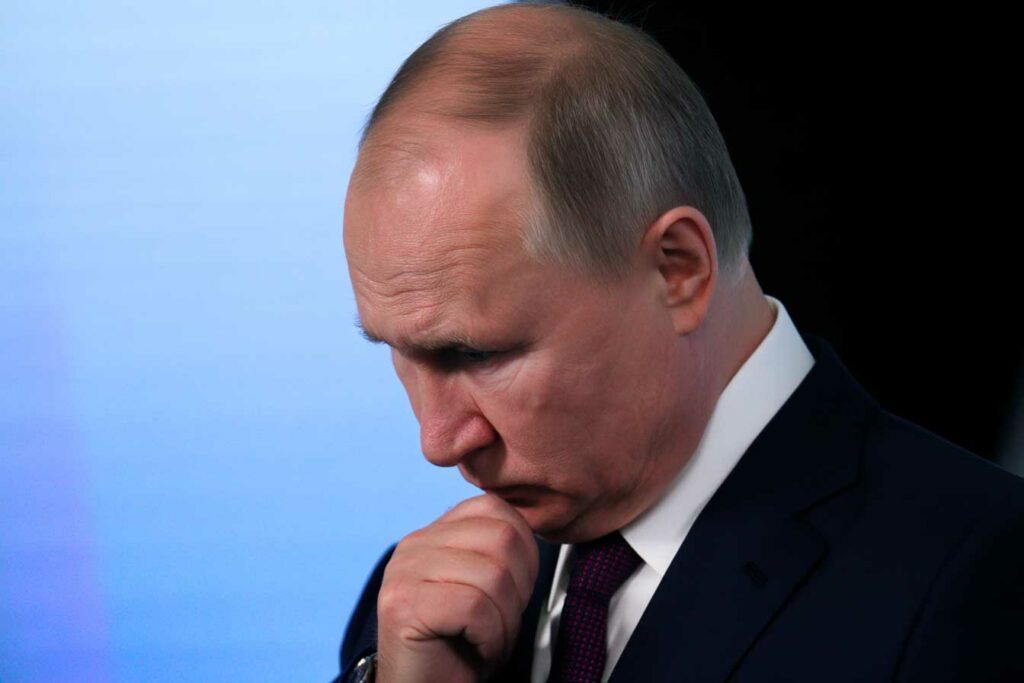
Russia, facing a deep economic crisis, is seeing its economy falter under the weight of the war in Ukraine, sanctions, and corruption.
Since the start of the war in Ukraine in 2022, Russia has faced a series of major economic challenges. International sanctions have isolated the country, leading to a significant decline in foreign investment and a contraction of its economy. Aging infrastructure, particularly the rail network, is struggling to meet logistical needs, while endemic corruption undermines the effectiveness of institutions. At the same time, massive military mobilization has exacerbated labor shortages, affecting various economic sectors. Despite modernization efforts, the Russian military industry suffers from shortages of equipment and advanced technologies. These factors combined point to a difficult year ahead for the Russian economy in 2025, with profound implications for its domestic stability and position on the international stage.
A declining economic system
Russia is experiencing an economic recession marked by a significant decline in its gross domestic product (GDP). According to International Monetary Fund (IMF) forecasts, Russian GDP growth is expected to slow to 1.4% in 2025, down from 4.1% in 2024. This contraction is attributed to a combination of factors, including economic sanctions imposed by Western countries, falling oil and gas prices, and declining foreign investment.
The sanctions have particularly affected key sectors of the Russian economy, such as energy, finance, and technology. For example, natural gas exports to Europe fell by 40% in 2024, significantly reducing government revenues. In addition, capital flight has intensified, with an estimated $150 billion leaving the country since the start of the conflict in Ukraine.
The ruble has also suffered significant depreciation, losing around 30% of its value against the US dollar between 2022 and 2025. This devaluation has led to rampant inflation, reaching 12% in 2025, which has reduced the purchasing power of Russian citizens and increased the cost of imports.
In response to these challenges, the Russian government has attempted to strengthen economic self-sufficiency by promoting domestic production and diversifying its trading partners, particularly by turning to Asia. However, these efforts have not been sufficient to offset the economic losses caused by sanctions and the war in Ukraine.
A railway network under pressure
The Russian rail network, which is essential for transporting goods across the country’s vast territory, faces major challenges. Network congestion, combined with a lack of investment in infrastructure modernization, has led to delays and logistical inefficiencies.
In 2024, the volume of freight transported by Russian railways fell by 9.3% compared to the previous year, reaching 87 million tons in February 2025. This decline is attributed to reduced exports, particularly to Europe, due to sanctions, as well as the redirection of trade flows to Asia, which has put additional pressure on existing infrastructure.
The lack of modern locomotives and suitable wagons has also contributed to this situation. The government has announced a reduction in investment in the rail sector from 1 trillion rubles in 2024 to 890 billion rubles in 2025, which could exacerbate the current problems.
The deterioration of the rail network is having an impact on the entire Russian economy, slowing down the transport of raw materials and finished products, which affects the competitiveness of businesses and limits economic growth.
An alarming labor shortage
Russia is facing a labor shortage unprecedented since the end of the Soviet Union. In 2024, the country recorded a deficit of 2.6 million workers, an increase of 17% over the previous year. This situation is exacerbated by several factors, including military mobilization, the emigration of young professionals, and an aging population.
The construction sector is particularly affected, with a 15% decline in the available workforce in 2025. Similarly, the manufacturing and service sectors are struggling to recruit skilled personnel, which is hampering their development and their ability to meet domestic demand.
To alleviate this shortage, the Russian government has attempted to attract migrant workers from Central Asia and Southeast Asia. However, these efforts are facing obstacles, such as difficult working conditions, low wages, and growing social tensions toward migrants.
The labor shortage has significant economic consequences, limiting production capacity, increasing wage costs, and slowing the country’s overall economic growth.
A struggling military industry
The Russian military industry, once considered a pillar of national power, now faces major challenges. International sanctions have restricted access to advanced technologies and essential components, hampering the production of modern weapons.
In 2025, Russia reported critical shortages in the production of drones, communication systems, and armored vehicles. Despite an increase in ammunition production, with approximately 250,000 artillery shells produced each month, these efforts are not sufficient to offset battlefield losses and meet operational needs.
Dependence on Soviet-era weapons stocks is also a problem. According to some estimates, Russia could exhaust its military equipment reserves by the end of 2025, jeopardizing its ability to continue prolonged military operations.
In addition, endemic corruption within the military-industrial complex has led to inefficiencies, misappropriation of funds, and poor resource management, further weakening the Russian military’s ability to modernize and maintain its technological superiority.

Disruptive systemic corruption
Corruption is a deeply entrenched problem in Russia, affecting all levels of government and the economy. According to Transparency International’s Corruption Perceptions Index, Russia ranks among the most corrupt countries, with a score of 29 out of 100 in 2024.
In the military sector, corruption has particularly serious consequences. Investigations have revealed that up to 80% of the military budget could be diverted by corrupt officials, leading to shortcomings in equipment, training, and troop morale.
Corruption also hinders efforts to modernize and diversify the Russian economy. Foreign companies are reluctant to invest in an environment where the rules of the game are skewed, contracts are awarded in an opaque manner, and property rights are not guaranteed.
This situation fuels popular discontent, erodes trust in institutions, and threatens the country’s social and political stability.
Geopolitical consequences and future prospects
Russia’s economic collapse has repercussions beyond its borders. Its diminished ability to project military and economic power weakens its influence on the international stage, particularly in Eastern Europe and Central Asia.
Neighboring countries, such as China, could take advantage of this situation to strengthen their position in strategic regions, such as the Russian Far East. At the same time, NATO could consolidate its presence in Eastern Europe in response to the perception of a weakened but still unpredictable Russia.
Domestically, the combination of economic recession, corruption, and social pressure could lead to protests and even major political changes. The Russian government’s ability to navigate this turbulent period will depend on its willingness to undertake structural reforms, fight corruption, and restore public confidence.
A desperate military gamble
The current situation could prompt Vladimir Putin to intensify military strikes in the hope of creating a favorable balance of power before Russia’s economic or social collapse. This type of strategy, known as a “desperate military gamble”, has already been seen in other conflicts where a weakened regime seeks to reverse the momentum by gaining a quick territorial or psychological advantage, even if only temporary.
The goal of restoring a position of strength for negotiations
Russian strategic logic is often based on the concept of “negotiating from strength.” Currently, Russia has nothing to offer in negotiations except increased military pressure. By launching massive strikes—on critical Ukrainian infrastructure, command centers, or symbolic cities—the Kremlin could hope to force a diplomatic “pause” or obtain concessions (Ukraine’s neutrality, a freeze on the territorial situation, partial lifting of sanctions).
Window of opportunity before capabilities are exhausted
The Russian defense industry is suffering from growing shortages (semiconductors, optoelectronic components, guided missiles, drones). According to several reports, precision missile stocks are declining, and monthly production is not compensating for usage at the front. If Russia wants to strike hard, it must do so before its stocks become critical, which could happen by the end of 2025, according to Western projections.
Military mobilization counterproductive but still possible
Russia has launched several waves of mobilization since 2022. Despite growing reluctance, a certain number of men can still be mobilized. Putin could, in a last-ditch effort, launch a saturation operation on the front, particularly in the Donetsk and Zaporizhia oblasts. Even without a strategic breakthrough, intensifying the front could create the illusion of an offensive dynamic, justifying a proposal for talks on terms favorable to Moscow.
Authoritarian reflex in the face of internal fragility
When authoritarian regimes are in crisis, they tend to externalize tensions, often resulting in an escalation of external conflicts. The intensification of military strikes could serve to divert the Russian population’s attention from shortages, inflation, and corruption, while perpetuating the narrative of war against the West.
Risks and limitations of such a strategy
However, this approach carries major risks:
- On the military front, Ukraine’s air defense capabilities (Patriot, NASAMS, IRIS-T) have been strengthened. Massive Russian strikes are now increasingly being intercepted, reducing their effectiveness.
- On the diplomatic front, a brutal escalation could further harden Western support for Kyiv, accelerating deliveries of heavy weapons, including long-range missiles and modern fighter jets such as the F-16.
- Domestically, a new massive military effort would require wider mobilization, risking social and political divisions, particularly in large cities where young people refuse to go to the front.
Putin may be tempted to intensify strikes in an attempt to gain tactical leverage before a major economic collapse. This is a high-risk gamble, which could also precipitate the breakdown of his military apparatus and Russia’s total diplomatic isolation. This type of option is typical of regimes in decline that seek to force an outcome before their structural capabilities collapse. However, at this stage, the real military gains that such a move could bring remain highly uncertain in the face of resilient and well-supported Ukrainian resistance.
War Wings Daily is an independant magazine.